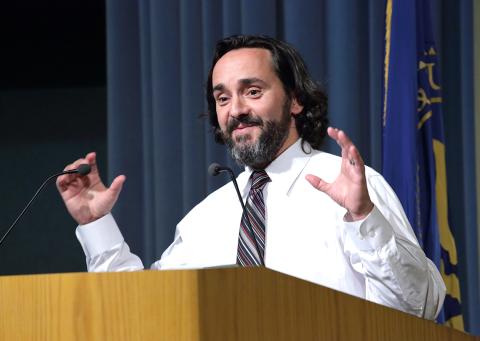Alternative Medicine
NIH’s Unconventional Journey Toward Integrative Health

Photo: Ernie Branson
What’s in a name? At the center of a decades-long debate, alternative medicine has been embroiled at the nexus of science, medicine and politics. The term alternative medicine itself is a loaded one, with passionate advocates and skeptics each fueling the feud.
We tend to fear the unknown. So, not surprisingly, alternative medical treatments—from homeopathy and herbal medicine to massage and chiropractic care—were long considered to be quackery. But such treatments were helping a growing number of people, piquing the interest of some senators. To explore the potential of alternative medicine, congressional funding helped launch the Office of Alternative Medicine at NIH 25 years ago. Since then, great progress has been made in a relatively short time.
Recounting the history of alternative medicine at NIH, Eric Boyle, chief archivist at the National Museum of Health and Medicine, spoke at an NLM History of Medicine lecture titled “In the Belly of the Beast” recently in Lister Hill Auditorium.
“I’d come across a number of practitioners and advocates who had persistently warned there were certain dangers in alternative medicine being swallowed whole by the behemoth NIH,” said Boyle, who started his career as an intern in NLM’s History of Medicine manuscripts division. “And this idea wasn’t terribly surprising given the fact that alternative medicine had been historically marginalized as unorthodox by many in the medical mainstream, and given the fact that the NIH was one of the nation’s foremost biomedical research institutions and arguably the center of medical orthodoxy.”
In 1991, the Senate appropriations committee—noting that many routine medical procedures such as cancer radiation therapy started out as unconventional—granted NIH a $2 million budget to create the Office of the Study of Unconventional Medical Practices (OSUMP), the first government-sponsored organization of its kind.
Almost immediately, skeptics worried that important conventional medicine projects were going unfunded at a time when research dollars were scant, said Boyle. They questioned whether these alternative therapies could be proven safe and effective. Meanwhile, advocates wanted these treatments to gain broader acceptance but wondered how best to test alternative medical treatments in the scientific arena.
“At the same time, the very name of the new office reflected the lingering stigma associated with what the media most commonly referred to as alternative medicine,” said Boyle.
While a rose by any other name might still smell as sweet to advocates, perhaps calling it something other than unconventional would give the field more credibility and clarity. Over time, the name would evolve from unconventional to alternative to complementary and alternative (CAM) to its present incarnation, complementary and integrative health.
Back in the early 1990s, a Harvard study revealed that one-third of U.S. adults used at least one alternative therapy. By 2002, 75 percent of American adults had tried some form of alternative medicine.
Attempting to explain the rising popularity of alternative medicine, a 1998 Stanford Center for Research in Disease and Prevention report found that some patients were dissatisfied with costly, ineffective conventional treatments, said Boyle. But mainly, the study suggested, patients found alternative therapies to be more aligned with their worldviews, values and philosophies toward health. Interestingly, the survey found a large percentage of patients satisfied with their conventional care and making use of alternative therapies to supplement their current care.

Photo: Ernie Branson
A 1997 survey abandoned the term unconventional for alternative. Said Boyle, “This change reflected a transformation in the acceptance of therapies previously given more dubious labels, and indicated that, for the most part, the medical profession by this point in time no longer uniformly characterized these practices as deviant, marginal, fraudulent or of little consequence, as it had for much of the 20th century.”
Discussions to abolish the term “unconventional” began back in 1992 at a meeting of HHS representatives, policymakers, scientists, doctors and academics in Chantilly, Va. Participants also concluded that alternative medicine could indeed be measured by scientific methodology. That year, NIH’s OSUMP became OAM, the Office of Alternative Medicine.
In 1998, OAM would become NCCAM—the National Center for Complementary and Alternative Medicine—which, said Boyle, “arguably reflected a broader effort to diffuse the historically antagonistic relationship with mainstream medicine and the connotation of the term alternative medicine itself.” Using the term complementary also suggested these are not methods of last resort, but rather plausible treatments where others may have failed. Furthermore, alternative medicine was complementary, an extension of primary care, often used in conjunction with—not instead of—conventional methods.
A series of conferences and meetings throughout the 1990s helped refine the definition and place of alternative medicine at NIH. At one working group meeting in 1995, analytical procedures were established to evaluate therapeutic efficacy and conduct clinical research on alternative medicine. The panel said alternative methods must endure the same degree of scientific scrutiny as conventional therapies, said Boyle.
That sentiment was echoed in a 1995 report published in the International Journal of Technology Assessment in Health Care, in which a panel of experts insisted randomized controlled research trials should underpin alternative medicine research.
In 2014, NCCAM changed its name once again, dropping “alternative”—to become the National Center for Complementary and Integrative Health—thus reflecting an evolving philosophy that allows patients to become more active participants in their own health and wellness, said Boyle.
“The history of alternative medicine and the current place of complementary and integrative health at NIH,” said Boyle, “each imparts a different vision of the work involved and its place in the fields of medical research and health care past, present and future.”
